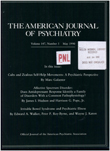Neuroanatomical abnormalities in obsessive-compulsive disorder detected with quantitative X-ray computed tomography
Abstract
New brain imaging techniques may provide evidence for a biological basis for severe psychiatric disorders. The authors used quantitative X- ray computed tomography (CT) to analyze the brain volume of 10 male patients with severe primary obsessive-compulsive disorder and 10 healthy male control subjects. Caudate nucleus volume in the patients with obsessive-compulsive disorder was significantly less than that of control subjects, but lenticular nuclei, third ventricle, and lateral ventricle volumes did not differ between these two groups, and no abnormal asymmetry of bilateral structures was detected. These findings support other evidence of involvement of the caudate nucleus in obsessive-compulsive disorder.
Access content
To read the fulltext, please use one of the options below to sign in or purchase access.- Personal login
- Institutional Login
- Sign in via OpenAthens
- Register for access
-
Please login/register if you wish to pair your device and check access availability.
Not a subscriber?
PsychiatryOnline subscription options offer access to the DSM-5 library, books, journals, CME, and patient resources. This all-in-one virtual library provides psychiatrists and mental health professionals with key resources for diagnosis, treatment, research, and professional development.
Need more help? PsychiatryOnline Customer Service may be reached by emailing [email protected] or by calling 800-368-5777 (in the U.S.) or 703-907-7322 (outside the U.S.).



